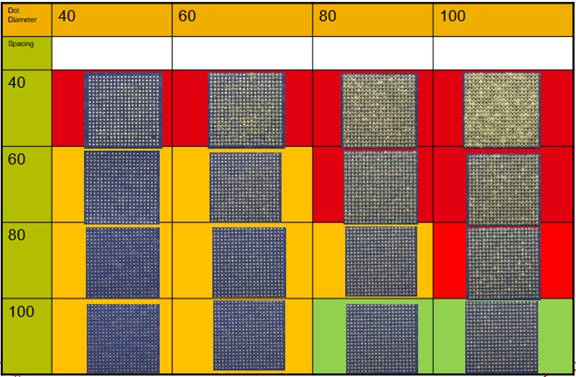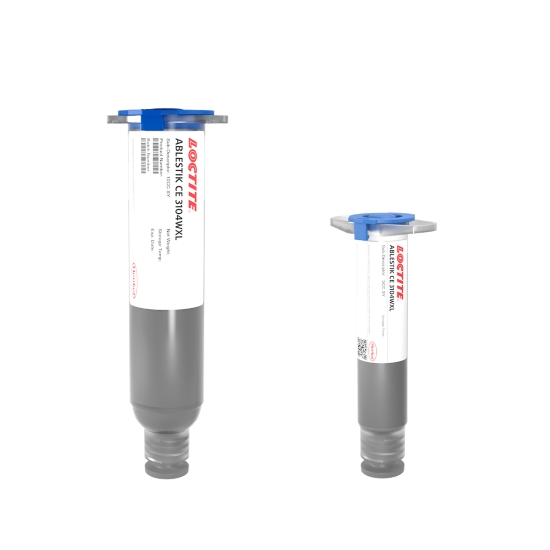LOCTITE ABLESTIK CE3104WXL
- Pb Free alternative to solder
- Electrically conductive
- Optimized for printing
Product Description
LOCTITE ABLESTIK CE 3104WXL is an electrically conductive epoxy adhesive that is a Pb-free alternative to solder. It is a rigid, silver filled epoxy that can be heat cured in low temperatures and is typically used for SMD component attach on non-noble Sn, Sn/Pb and OSP coated Cu substrates.
LOCTITE ABLESTIK CE 3104WXL uses a unique blend of fillers with tightly controlled particle sizes to provide ultra-fine pitch resolution (<500µm) when printed using either a stainless steel mesh screen or a metal mask stencil. The lower surface tension versus solder means no bridging on fine-pitch assembly patterns.
Cure Schedule
- Reflow:
- 3 minutes @ 150°C or
- 5 minutes @ 125°C
- Convection:
- 8 minutes @ 125°C or
- 5 minutes @ 150°C
Technical Specifications
| General Properties | |||||||
| |||||||
| Work life @25°C Work life @25°C Work life is the amount of time we have to work with a material until it is no longer able to be easily worked and applied on a substrate. It is based on the change in viscosity and it can rely on the application requirements. | 72 hours | ||||||
| Physical Properties | |||||||
| Thixotropic index Thixotropic index Thixotropic Index is a ratio of a material s viscosity at two different speeds in Ambient temperature, generally different by a factor of ten. A thixotropic material s viscosity will decrease as agitation or pressure is increased. It indicates the capability of a material to hold its shape. Mayonnaise is a great example of this. It holds its shape very well, but when a shear stress is applied, the material easily spreads. It helps in choosing a material in accordance to the application, dispense method and viscosity of a material. | 6 | ||||||
| Viscosity Viscosity Viscosity is a measurement of a fluid’s resistance to flow. Viscosity is commonly measured in centiPoise (cP). One cP is defined as the viscosity of water and all other viscosities are derived from this base. MPa is another common unit with a 1:1 conversion to cP. A product like honey would have a much higher viscosity -around 10,000 cPs- compared to water. As a result, honey would flow much slower out of a tipped glass than water would. The viscosity of a material can be decreased with an increase in temperature in order to better suit an application | 65,000 mPa.s | ||||||
| Thermal Properties | |||||||
| |||||||
| Glass Transition Temperature (Tg) Glass Transition Temperature (Tg) The glass transition temperature for organic adhesives is a temperature region where the polymers change from glassy and brittle to soft and rubbery. Increasing the temperature further continues the softening process as the viscosity drops too. Temperatures between the glass transition temperature and below the decomposition point of the adhesive are the best region for bonding. The glass-transition temperature Tg of a material characterizes the range of temperatures over which this glass transition occurs. | 100 °C | ||||||
| Thermal Conductivity Thermal Conductivity Thermal conductivity describes the ability of a material to conduct heat. It is required by power packages in order to dissipate heat and maintain stable electrical performance. Thermal conductivity units are [W/(m K)] in the SI system and [Btu/(hr ft °F)] in the Imperial system. | 1.8 W/m.K | ||||||
Additional Information
In the following image you can see that the CE 3104WXL stencil printing results with 25um stencil showing that 80-100um dot diameter with 100um spacing (or 200um pitch) look good, but smaller dots and pitch are getting tricky.
The results are color coded so 100um spacing exhibits proper printing with larger dot diameters.




